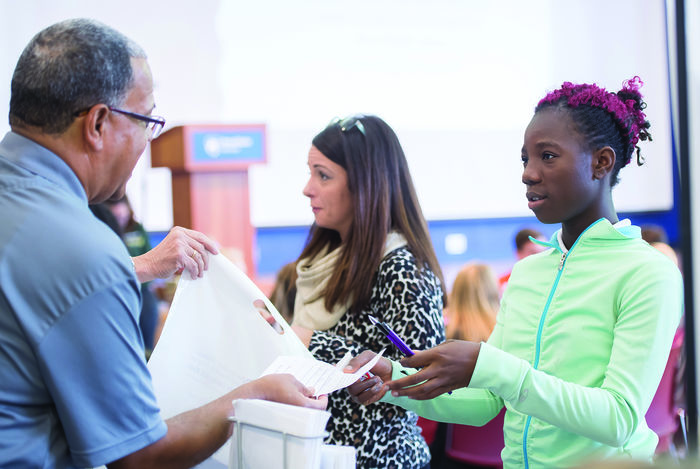Peers are of paramount importance to teenagers. What young people do, think, and say, and how they behave, has a tremendous influence on those around them—positive or negative.
Recognizing this, staff members at Positive Youth Development (PYD) of Erie County are training middle- and high-school students to be positive leaders and agents of change in their schools. PYD is part of the Susan Hirt Hagen Center for Community Outreach, Research and Evaluation (CORE), an outreach program of the School of Humanities and Social Sciences at Penn State Behrend.
A youth summit at Behrend this fall drew more than 100 teens from regional schools to learn more about 40 Developmental Assets for Adolescents, a set of building blocks for healthy development. The students brainstormed ideas for how the developmental asset framework can be applied at their own schools.
“If we can reach students at this vital, impressionable time, it can change the trajectory of their lives,” said James Hodge ‘09, director of evaluation at CORE. “And who better to reach them than the people they listen to most at that age? Their peers.”
40 Developmental Assets for Adolescents is a program of the Search Institute, an organization that pioneered using social science research to understand the lives, beliefs, and values of young people. Developmental Assets are research-based, positive qualities that help adolescents grow up healthy, caring, and responsible. These assets include things such as parent involvement in schooling, caring school climate, positive peer influence, high expectations, youth programs, selfesteem, peaceful conflict resolution, and a sense of purpose.
“The more assets that young people have, the less likely they are to engage in high-risk behaviors and the more likely they are to thrive at home, at school, and in the community,” said Abbe Biebel ’15, Positive Youth Development coordinator.
Unfortunately, the average young person possesses fewer than half of the assets.
“PYD’s mission is to change that,” Biebel said. “We collaborate and work with dozens of organizations in the area to increase the Developmental Assets for at-risk adolescents. The Youth Summit is a grass-roots example of that.”
At the Youth Summit, students analyzed their schools’ strengths and weaknesses within the Developmental Assets framework and planned a project to strengthen at least one of the weaknesses.
Ideas generated included: a two-day club expo to boost membership and participation in organizations that provide a sense of belonging and community; and a game day in which families were invited to the school a few times a year for an evening of food, games, and fun.
The students will return to Behrend in May for another summit, where they will report on the activities and events initiated at their schools. Students will also be formally recognized for their service to their schools and community. “We are really excited to see how it goes for our youth leaders,” Hodge said. “Not everything they try will be successful, but that’s part of the experience. Learning from efforts that don’t work encourages a flexible view of intelligence and effort and builds resilience, self-esteem, and competence.”
